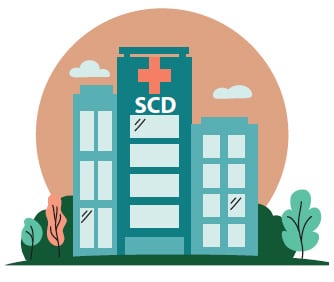What to know
This Steps to Better Health fact sheet provides easy-to-read information for people with sickle cell disease (SCD) about managing acute pain.

Overview
If you have sickle cell disease (SCD), you may experience acute pain (often called a pain crisis), which starts suddenly and usually lasts less than a month. Pain management is different for everyone. It is important that you and your healthcare provider work together to make decisions about the best treatment for you.
Create an individualized pain management plan with your provider.
An individualized pain management plan, prepared by your provider, is a document that contains your contact details and treatment information specific to your health needs, including dosage of your pain medicines. Work with your provider to make and follow an individualized pain management plan. Remember to do the following:
- Talk to your provider about your health history, including past pain management.
- Stay informed about the risks and benefits of prescription opioids. Prescription opioids, such as oxycodone, hydrocodone, and morphine, can be prescribed by doctors to treat moderate to severe pain but can also have serious risks and side effects. Learn more here.
- Make sure you can access your plan (electronically or a print copy) when you receive care.
- Work with your provider to update your plan yearly.

Know your options for treating pain.
- Opioids are commonly used to manage moderate to severe pain, but some patients may have acute pain that does not respond to these medicines. Talk to your provider about options that you can take instead of, or in addition to, opioids.
- Ketamine, an anesthetic generally used for surgery, can also help treat SCD-related acute pain.
- Nonmedication options for pain management include the following:
- Massage.
- Yoga.
- Transcutaneous electrical nerve stimulation (TENS; use of electric currents to treat pain).
- Virtual reality.
- Guided audiovisual relaxation.

Before you have a pain crisis, find a SCD-specific acute care facility.
If you have a pain crisis, it is best to seek care at an SCD-specific acute care facility, if possible, including
- Day hospitals (an outpatient facility where patients seek care during the day and then return home), and
- Infusion centers (an outpatient facility that provides specialized care for sickle cell crises).
These facilities are better equipped to evaluate, diagnose, and treat SCD-related acute pain than emergency departments (EDs). If you need to seek care in an ED, be sure you have access (electronically or a print copy) to your individualized pain management plan when you go.

Visit the "Sickle Cell Disease: Steps to Better Health" toolkit available here.
This information is based on ASH SCD Guidelines: Management of Acute and Chronic Pain.
